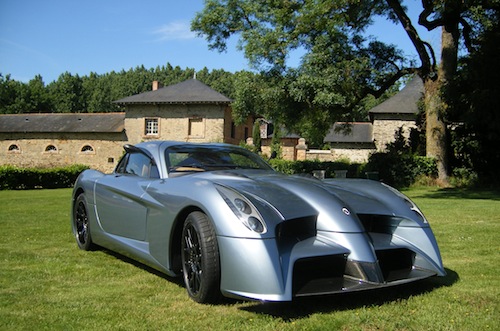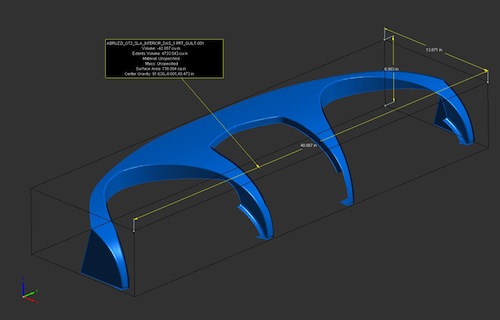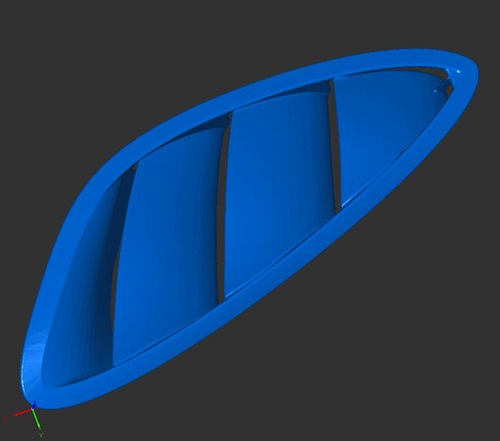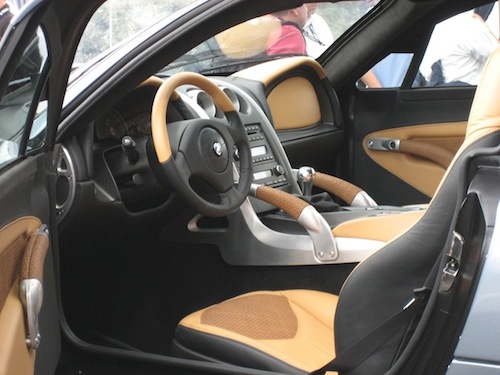June 22, 2012
By Solid Concepts
Editor’s note: This article is sponsored by Solid Concepts Inc.
In a town about 50 miles northeast of Atlanta, GA a group of engineers who work inside a converted 2,000 square-foot Department of Transportation salt storage shed, are building the US versions of limited production, high performance automobiles. The company has been building cars since 1989 when the Panoz Auto Development Company was founded. Since then they’ve introduced a line of roadsters, sports cars, and racecars.

The Abruzzi prototype was partially built using the latest rapid prototyping technologies.
According to their mission statement “Every Panoz automobile is designed, engineered and built with the pride and passion once found in cars brought to life by those who believed driving should be an experience, not simply a means of transportation.” The company has gone out of its way to prove this statement every time they’ve introduced a new vehicle. The Abruzzi was no exception.
As with any manufacturing company, prototypes are a necessary step in final design. While prototyping the Abruzzi, engineers at Panoz were also up against unusual time constraints. By the time designs were finalized, the time they had to build a prototype was limited. What made things worse was that the company’s marketing plans included the general release of a few “teaser images” of the Abruzzi “Spirit of Le Mans” supercar.

This is a screen shot of one of the dashboard components for the Abruzzi supercar.
Eventually the Abruzzi debuted at the 24 Hours of Le Mans auto race in France on June 8th 2010. The company didn’t want to release paintings of the car as so many other companies did. Instead they required that the images be photos taken from the actual car body, the same one that would be presented at its debut.
According to one of the engineers on the team, Nathan Treat, “The Abruzzi was to be a next generation, 600 horsepower supercar. Our design expressed the emotion behind such an important introduction. But because of our swiftly approaching deadline we had a very short manufacturing lead-time. Literally not enough time to cut tools and make carbon fiber parts, let alone assemble and paint them.”
The company required quick build times for over fifty different geometries of interior and exterior components, including nine pieces that would eventually be mounted together to produce the dashboard. Other interior components included the center console and armrests. “All of the components for the interior were going to be covered with either one of a variety of different leathers or Alcantara ®, a suede-like material used for its elegant look and durability. This meant that the color of the prototypes wouldn’t be an issue, and they wouldn’t need to be sanded or prepped in any way before use “another time savings.

The hood louver shown here is one of the parts that uses an aluminum filled Nylon material to gain strength and rigidity.
Engineers at the company designed the supercar using Unigraphics CAD software. The three-dimensional designs created inside Unigraphics were easily converted to STL files, which were then uploaded to Solid Concepts (Valencia, CA), the company selected to provide the final components. Specialists at Solid Concepts reviewed the CAD models and drawings, and then uploaded the data to the company’s production machines. Panoz called on Solid Concepts because they are a service organization with a broad spectrum of capabilities from overnight delivered PolyJet prototypes to specially machined or fabricated manufactured parts. The company, guaranteed to deliver the proper prototyped parts in time for the Panoz team to put the vehicle together for its introduction.
Nathan said that they chose to have the components created using a Selective Laser Sintering process (SLS), which is an additive rapid manufacturing process that builds three-dimensional parts by using a laser to selectively sinter (heat and fuse) a powdered material such as Nylon. The process began with the 3D CAD design files uploaded from the Unigraphics CAD system. The geometries were then mathematically sliced into 2D cross-sections for upload to the SLS machine. The part is then built layer by layer until it is completed.
Parts created using SLS can be made from a range of materials, including Nylon-11 and Nylon-12 polyamides, or nylons with fillers such as glass beads, Aramid or carbon fibers (to enhance physical properties), and a variety of other metals. Depending on the material, up to 100% density can be achieved with material properties comparable to those found with traditional manufacturing methods, which is why SLS is such an attractive prototyping method. “Most of the parts were useable as we received them,” Nathan said. “We made only one set of most of the parts, which came out perfectly. The only exceptions were the curved window drop rails, the hood louvers, and the rear hatch louvers. These parts required that we increase their sturdiness by having them produced as aluminum filled parts,” he said. “Nothing about the actual design of those components changed.”

The Abruzzi interior is elegantly highlighted gluing a variety of leather materials to SLS components.
All the components on the exterior were sanded and painted for a smooth looking surface. SLS components are heat and chemical resistant and readily joined mechanically or with adhesives, both methods used by the Panoz team. Because of the process’s ability to provide detailed feature definitions that are designed into the part, and because the end products are durable and offer long-term stability, SLS is an excellent choice for producing functional prototypes, like the Abruzzi body, without the high expense of tooling.
Nathan said, “It took only four days from the time we sent the files to having the parts at our doorstep “a deadline that could not have been kept in any other way.” After the prototype was displayed Nathan explained that they would continue refining the design of the mechanical systems, performing research and development testing using the prototype body they designed and built. “Changes will continue to evolve until production tooling is designed. The body design will probably go through only minor changes, holding close to the prototype design,” he said.
More Information:
Panoz Auto Development Company
1101 Highway 124
Hoschton, GA 30548
Phone: 770-867-4796
Website: www.panozauto.com
Solid Concepts Inc.
28309 Avenue Crocker
Valencia, CA 91355
Phone: 661-295-4400
Website: www.solidconcepts.com
Subscribe to our FREE magazine, FREE email newsletters or both!
About the Author
DE’s editors contribute news and new product announcements to Digital Engineering.
Press releases may be sent to them via [email protected].






